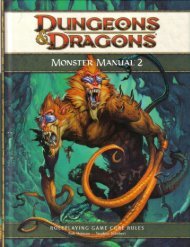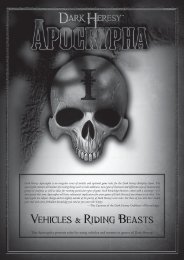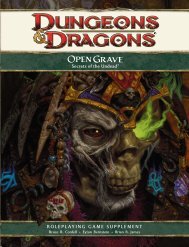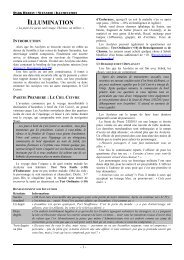You also want an ePaper? Increase the reach of your titles
YUMPU automatically turns print PDFs into web optimized ePapers that Google loves.
Other <strong>dragons</strong> that survived Io’s death embracedtheir physical link to the Elemental Chaos, allowingthe power within them to manifest externally.They became disasters incarnate, taking the formsof fantastic catastrophes that shook the world andthat continue to wreak havoc millennia later. Whena mountain explodes, a catastrophic dragon mighterupt from it along with sprays of molten rock. Whena cyclone or a hurricane rages, a catastrophic dragonmight lurk at the eye of the storm, reveling in thedestruction. Catastrophic <strong>dragons</strong> care little forwealth or power. They seek to make their marks onthe world, literally, and to have others fear and propitiatethem.The order of scourge <strong>dragons</strong> also arose fromamong the survivors of Io’s death. Similar to theway catastrophic <strong>dragons</strong> embraced their link to theElemental Chaos, scourge <strong>dragons</strong> (also called linnorms)celebrated their connection to brute reality.They learned to visit afflictions upon living creatures.Almost universally evil, scourge <strong>dragons</strong> enjoy theraw physicality of melee combat.The remainder of Io’s surviving dragon childrenthrew in their lot with Tiamat, whose hatred of theworld that killed her father colored her every deedand attracted <strong>dragons</strong> given to rapacity and suspicion:the <strong>chromatic</strong>s. Chromatic <strong>dragons</strong> have becomethe best-known dragon family thanks to their oftenantagonisticrelationship with humanoids. LikeBahamut, Tiamat matured into a deity appealing tomore than just her dragon kin. Today, as the evil deityof wealth, greed, and envy, she urges her followers totake vengeance for every slight. Most <strong>chromatic</strong> <strong>dragons</strong>follow this dictate.Planar <strong>dragons</strong> are categorized as the fifth familyof <strong>dragons</strong>, but planar <strong>dragons</strong> did not appear untillong after the other dragon classes matured in theaftermath of Io’s dissolution. Dragons that emigratedto offworld planes were affected by their environment,sometimes radically. Chromatic <strong>dragons</strong> seemmost susceptible, and later generations of theseplanar <strong>dragons</strong> bear only slight resemblances to theirworldly kin.PHYSIOLOGYAs any would-be <strong>dragons</strong>layer should know, <strong>dragons</strong>—also called wyrms—are far more than merely giantbeasts or winged lizards. Chromatic <strong>dragons</strong>’ abilitiesset them at the top of the food chain and make themthe most potent hunters of the natural world.Dragon TraitsWhat, exactly, makes a dragon? Other magical, reptilianbeasts have great power. A few creatures, suchas drakes and wyverns, share certain characteristicswith <strong>dragons</strong>. What sets <strong>dragons</strong> apart from them?All true <strong>dragons</strong> have distinct age categories andgrow in power and strength as they progress throughthose categories. Every <strong>chromatic</strong> dragon has both abreath weapon and an array of supernatural abilities,including an aura that induces overwhelming fear.All <strong>chromatic</strong> <strong>dragons</strong> also have the same basic bodystructure.External AnatomyCovered in scales, possessed of four legs and a long,writhing tail, a dragon appears to be a giant reptile atfirst glance. Nevertheless, <strong>dragons</strong> are a classificationunto themselves, with characteristics of predatorymammals as well as reptiles. In fact, a dragon’s externalanatomy—with four legs directly beneath the bodyrather than splayed to the sides—is more mammalianthan reptilian.Sense OrgansAt the center of a dragon’s eye is a thin, vertical pupil,like that of a cat. Whereas a cat’s pupil expands toadmit more light in dark areas, however, the expansionof a dragon’s pupil allows primal energy flowingin the creature’s bloodstream to emanate from thepupil (see “Internal Anatomy”). This minute seepageof magic grants a dragon its darkvision.Chromatic <strong>dragons</strong> do not have external ears.As with snakes, an internal mechanism detectssounds. From the outside, the only evidence of thismechanism is a tiny hole between the scales. Some<strong>dragons</strong> have frills or fringes of scales along theirheads; in such cases, one such set of scales might surroundthe auditory canal, focusing sound inward ina manner similar to that of a mammal’s external ear.These scales are not, however, a necessary part of thedesign.Due to their scales and thick hides, <strong>chromatic</strong><strong>dragons</strong> have a poor tactile sense. Hence, a dragoncan be comfortable sleeping on a jagged pile oftreasure, as long as the pile vaguely conforms to thedragon’s shape. Dragons are, however, sensitive topain. Anything capable of penetrating their hide andscales receives their full attention.A <strong>chromatic</strong> dragon’s sense of smell is splitbetween its nostrils and its tongue. The nasal aperturecan detect odors from a great distance, but thataperture is less capable than the tongue of differentiatingan odor’s components. When a dragon drawsnear the source of an interesting scent, its flickeringtongue identifies and pinpoints various odors, muchas a snake’s tongue does.The tongue is also a dragon’s organ of taste.Dragons can detect nuances of flavor better thanhumanoids can. For example, a dragon couldPHYSIOLOGYCHAPTER 1 | Dragon Lore7









